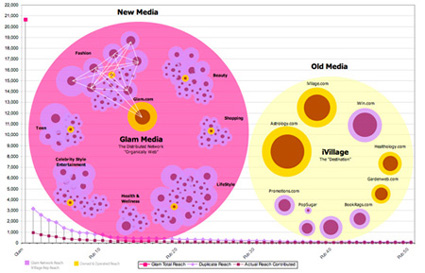What exactly is Glam?Phil J pointed me to this story - one where all the buzzwords are out in force. There are quite a few opinions out there discussing Glam.com's business model. Is it a network? Is it a platform? Is it 2.0 vs 1.0? Is it rubbish? Well, I haven't read Jarvis for a while, and having read through his opinion on it I think I need to drop by more often: The yellow circle on the right represents iVillage, which had been the largest womenís site in the U.S. After only a year and a half, Glam has overtaken it as the new No. 1 with 23 million uniques (vs 18m for iVillage) and 600 million monthly pageviews.
Glam, represented by the larger circle on the left, is a network. Youíll see clusters made up of smaller circles, representing their content areas: fashion, beauty, fashion, lifestyle, celebrity, teen. Inside each of those clusters, if you squint, youíll see a small yellow circle. Those are Glamís O&O (owned and operated) sites. All the many purple circles around those in each cluster represent outside, independent blogs and sites in Glamís network. That is the secret to Glamís quick growth without the cost and risk of doing everything itself.
Glam finds the good blogs and creates a relationship. It features good content from them on Glam and also sells ads on the blogs, sharing revenue with and supporting those bloggers. It now has about 400 publishers creating about 600 sites and Arora said that some make multiple six figures a year.
"30-40% of Glamís revenue is O&O, and 20-30% of Glamís impressions are O&O . . . . 30-35% of Googleís Impressions are on Google.com, 60-50% of Revenue is Google.com vs its network."
So Glam is a content network. But they donít create all the content. They curate it. So we should curate more as we create less. Thatís another way to say what Iíve said other ways: Do what we do best and link to the rest. Also: We need to gather more and produce less, so we also need to encourage others to produce more so we can gather it. Thatís a festival of PowerPoint lines there.
Glam is also and advertising network that supports the creation of content. Thatís how you encourage others to produce more.So in the end, Glam is really a platform. Thatís the key. Thanks Jeff. Be back soon. Technorati Tags: portal, strategy, visualization, networks, glam
Friday, November 23, 2007



 Comments: Comments:
Michael Arrington didn't agree with Mr. Jarvis so much.
This is an awkward time for social networks like Glam; their product is a commodity and each passing day weakens the tenuous chains binding content producers to publishing platforms.
It's the ad networks where the interesting stuff is happening. Follow the money. :-)
# posted by David Blanar : 8:01 PM, November 23, 2007
Hi David. Nice to see you on i-boy!
Yeah, I noticed Arrington didn't agree much. He's the link to "Is it rubbish?" ... But I'm not sure he has it right on this one.
Glam isn't a social network, is it? It is more a content and targeted advertising platform, don't cha think?
Arrington is great for start-ups, gossip and hype ... Jarvis is a sharp mind when it comes to the content biz online, as is Rafat over on PaidContent.
# posted by George Nimeh : 1:55 AM, November 24, 2007
Hi George - yes, Glam is more than a content platform, it's a fledgling vertical ad/content network, and it's popular. My question: what is its competitive advantage?
After all, we've had lots of content networks, I'm sure there will be lots more. As I see it, it an issue of friction: which publishing platform couples best with the most efficient ad delivery mechanism? Efficiency is the key.
All of the previous discussions apply, of course; micro-targeted, results-orientated, conversion-based campaigns will become our lingua franca and that's a good thing.
In the meantime, I'm racking my brain to figure out how we can develop a content delivery mechanism that is market-based, like a stock exchange. How we consume media - be it voice, data or otherwise - will be irrelevant, money will be exchanged at the friction points in the system. Crazy talk, I know, but as everyone says: information wants to be free. And free doesn't pay the bills.
# posted by David Blanar : 4:10 PM, November 26, 2007

|





 Comments:
Comments:




